Chadar Trek Frozen River

Region
Ladakh | India

Duration
8 Days

Max Altitude
11100 Ft.

Trekking Km
28 KM

Grade
Difficult
Get in Touch with Our Trek Expert
91 7351523841 info@trekthehimalayas.comMonday - Saturday: 10 AM to 09.30 PM (GMT +5:30)
Sunday: 10 AM to 05.30 PM (GMT +5:30)
26500 /Person
- January-2026
- Services Leh to Leh.
- Centrally heated rooms in Leh
- Attached washroom with running water available.
- Local sightseeing is included on Day 2
Add-ons
Offload 3500
- Backpack offload is optional.
- Choose add-ons during booking. If missed, log in and add them later.
- Book off-load at least 10 days before the trek.
- For offline bookings at the base camp, a convenience fee of Rs. 4000 applies.
- Offload can't weigh more than 11kg. Offload should have a waterproof cover. Suitcases/trolleys will not be allowed.
- In the event that you choose to cancel your trek prior to the departure date, you will receive a full refund.
- + 5% GST will be applicable
Get in Touch with Our Trek Expert
91 7351523841info@trekthehimalayas.com
Monday - Saturday: 10 AM to 06 PM (GMT +5:30)
Overview
Trek Name: Chadar Trek Frozen River
Days: 8
Adventure Type: Trekking
Base Camp: Leh
Season:Winter |
Month:January |
Country: India
Altitude: 11100 Ft.
Grade: Difficult
Rail Head: -
Stay: Hotel(Separate male & Female) & Camping
Food: Meals while on trek
Location: Ladakh
Distance: 28 Km.
Trail Type: Point to point trail | Camping at the same location upon returning.
AirPort: Leh (Kushok Bakula Rimpochee)
Highlights:
- Services Leh to Leh.
- Centrally heated rooms in Leh
- Attached washroom with running water available.
- Local sightseeing is included on Day 2
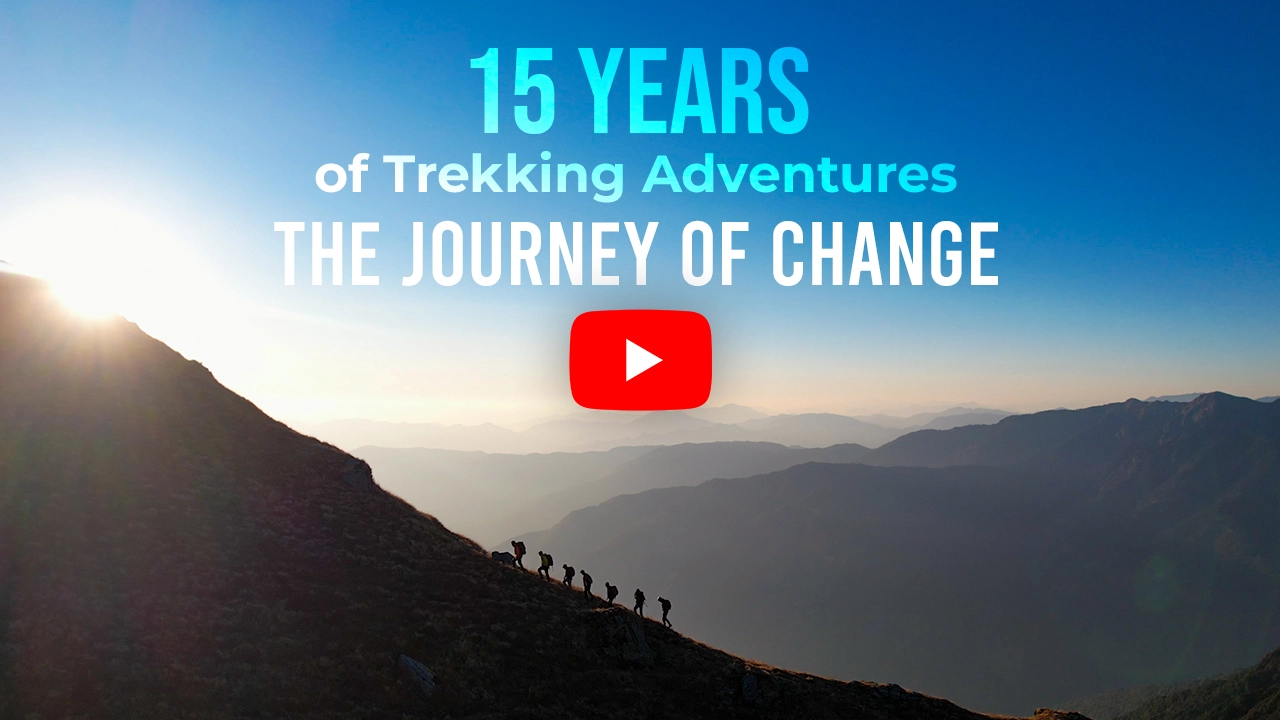
Why Chadar Frozen Trek Is A Must-Do Trek?
- The Chadar Frozen Trek is renowned as one of the world's most iconic and challenging treks, offering a unique and extraordinary experience for adventurers.
- Takes trekkers through the starkly beautiful and remote landscapes of Ladakh, providing an opportunity to witness the untouched beauty of the region.
- Trekkers traverse the frozen Zanskar River, experiencing the thrill of walking on a solid ice sheet, transforming the river into a surreal frozen wonderland.
- Trekkers face extreme winter temperatures, with the mercury often plummeting well below freezing, reaching as low as -30°C (-22°F) during the night. This challenging environment adds an element of resilience to the trek.
- Provides an incredible cultural experience as trekkers pass through the remote villages and interact with the local communities along the frozen river.
- Highlights the awe-inspiring Nerak Waterfall, a significant milestone on the trek. The frozen cascade of ice is formed due to the chilling temperatures, creating a mesmerizing natural wonder.
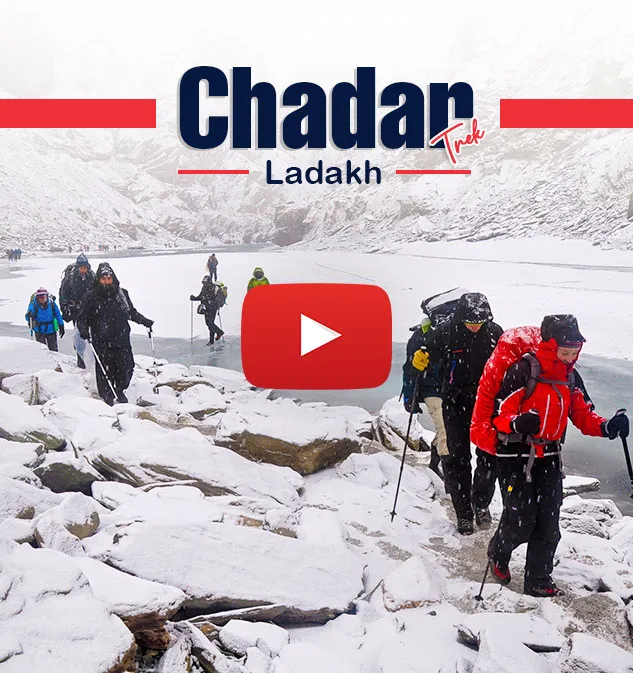
Who Can Participate
- Age Requirement:
- Minimum 16 years
- First-timers are welcome, though prior trekking experience is preferred. Good fitness is a must.
- Fitness Criteria:
- If the trekker wants to carry a backpack then he/she should be able to carry a 10-12 kg backpack. If opt Off-load option then the Trekker should be able to carry 3-5 kg backpack.
- If a trekker's BMI is more or less than the normal range (18-26), please consult our Trek Coordinator before booking.
Chadar Trek Frozen River Itinerary
Arrival at Leh
- Altitude Leh: 3505m / 11,500 ft
- Accommodation: Hotel
To witness the marvellous Chadar Trek, you first have to land at Leh airport, which is one of the most attractive airports. Even as you are about to reach Leh, you will start seeing its beautiful land full of snow-draped mountains. It's advisable and important to keep your warm clothes handy, as you will feel the sudden drop in temperature. A jacket, woollen gloves, and a woollen cap will be easy to carry.
Once you arrive at the hotel, the TTH team will be there to assist you. Please note that airport pickup and transfer are not included in the trek cost. The rest of the day is yours; you can rest and relax well. Leh is situated at around 11,500 ft, so it is important to note that your body needs to adapt as per the altitude. Try to drink a lot of water, avoid unnecessary work, give your body proper rest and wear warm clothes to not catch a cold.
If you feel relaxed and comfortable, in the afternoon you can take a short walk and stroll around the Leh market. You will love the local shops, people, but remember to keep yourself relaxed, not in a rush. Later in the evening, you will meet your fellow trek mates, trek leader, and all TTH team. There will be a short briefing about the upcoming journey. The trek leader will guide you through trek routes, safety protocols, important gear, weather conditions, key points, etc. You can ask your doubts as well. It is also a good time to connect with your trek mates, you can introduce each other and discuss the further journey together.
The team will help you with your gear selection. If you have any questions regarding what to carry, how to use any particular gear, you can freely ask them directly. Listen to your trek leaders carefully and follow the instructions accordingly. Enjoy your rest of the night and rest well.
Note: Due to ongoing road construction, the visit to Nerak Waterfall is only allowed on Sunday and Wednesday. You will be taken to Nerak on whichever of these days falls during your trek itinerary.
(Nerak is one of the main highlights of the Chadar Trek. The frozen waterfall looks fully covered in ice, and is one of the most beautiful and popular photo points of the trek.)
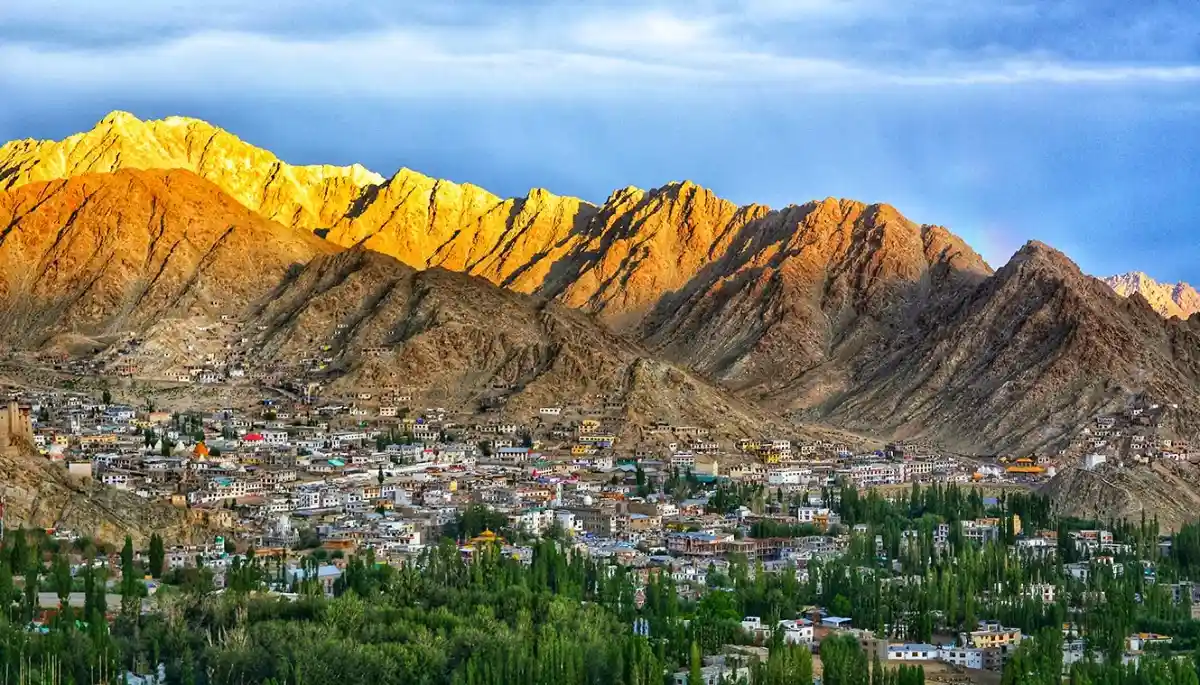
Acclimatization Day
- Altitude (Leh): 3505m / 11,500 ft
- Accommodation: Hotel
Today, Day 02 is kept for Acclimatization. When visiting any high altitude place, acclimatization is a must to give your body proper rest and let it adapt as per the surrounding! Hence, your second day of the Chadar trek is especially designed for it.
By now your body has already started adapting to the high altitude, but to make the journey ahead smooth and carefree, you still need to take it slow. You will also get a chance to visit some of Leh’s popular attractions like Shey Palace, Druk Padma Karpo School (also known as the 3 Idiots school), Thiksey monastery, Hall of Fame, etc. The transport for sightseeing will be arranged by the TTH team, while the entry fees at these sites will be borne by the trekkers. Also, please keep in mind to avoid visiting high-altitude areas like Khardung La Pass, as it may hinder the acclimatization process.
The rest of the day is yours, whether you explore, walk, or just relax. You can enjoy your time at Leh, but again it is best to stay within lower altitudes. After your dinner, you can rest well for the next day.
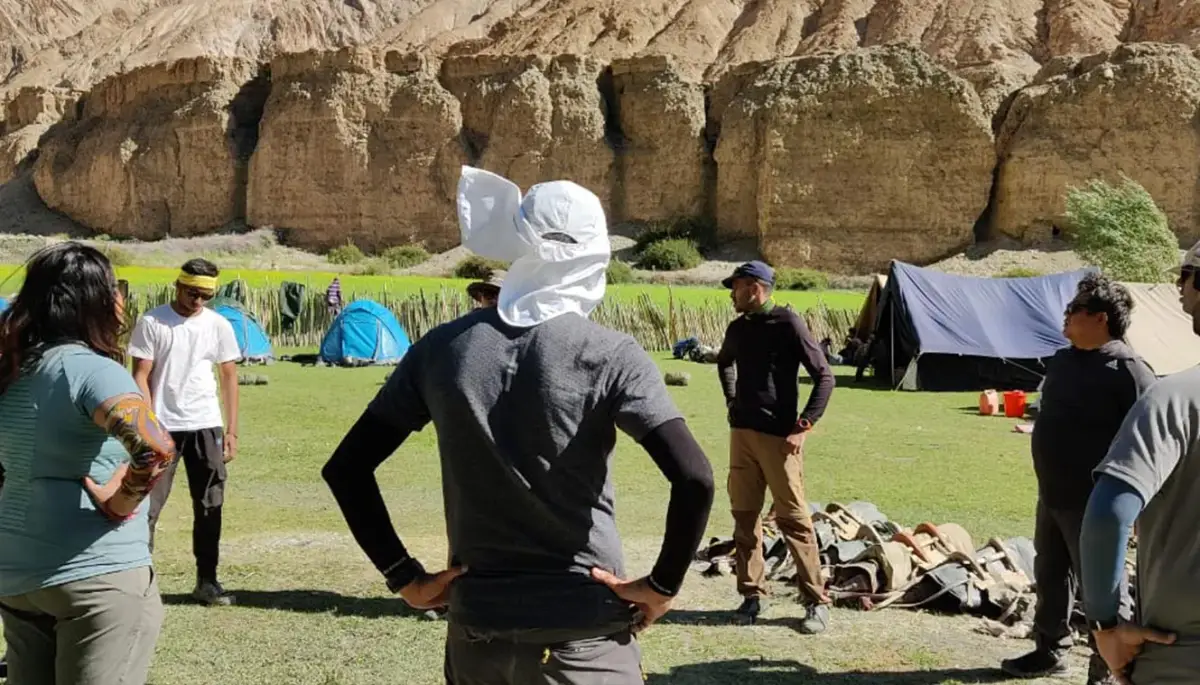
Medical Test Day in Leh
Today is a Medical Check-up day and it is very important for every trekker to get checked. Also important because if any one could not clear this medical test, they are not allowed to trek further for the chadar trek. This medical test ensures that every trekker is fit for the weather conditions of the Chadar Trek.
It is a mandatory medical test. The doctors will check your oxygen level, blood pressure and overall health conditions.
Once the medical clearance is complete, the TTH team will help you with the other procedures. The rest of the day is free for you to explore Leh’s beautiful sights. You can visit and explore the places. And if you are missing anything, you can buy from the local markets. At night you can enjoy your dinner and rest well for the upcoming journey. The journey of the legendary Chadar trek!
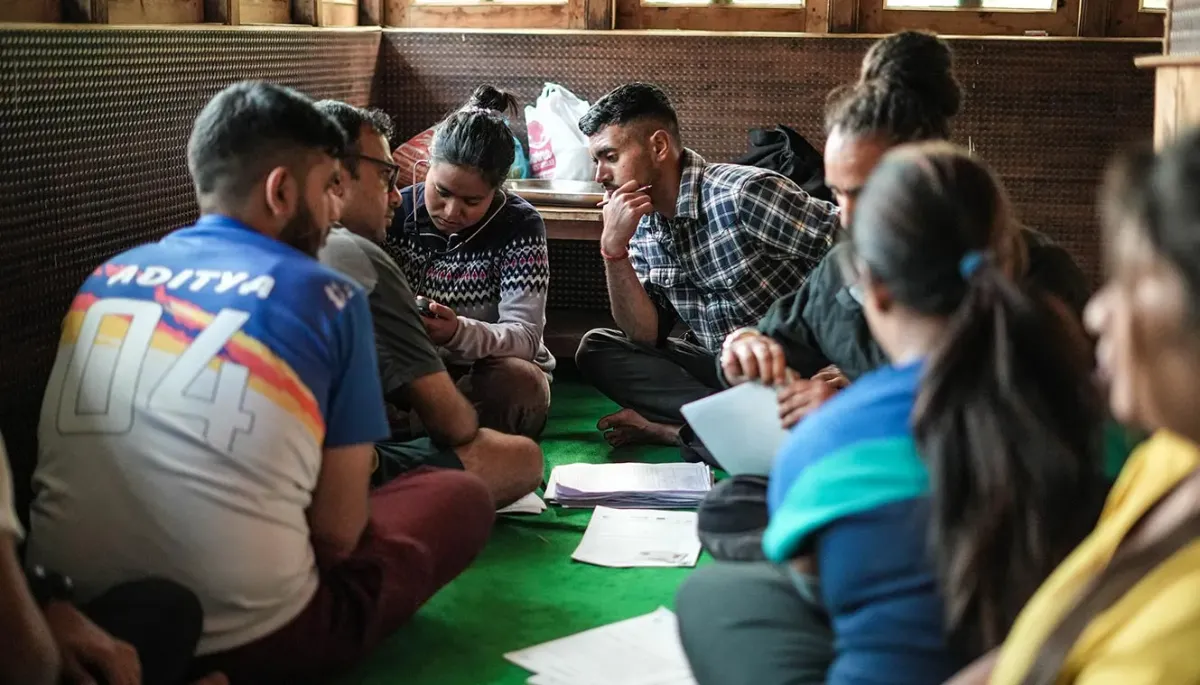
Today is the big day. This day decides whether you continue further or not. Wake up early and reach the Medical Camp as early as possible. Even though tests take less time, due to tourist rush it gets delayed. In the late afternoon we shall finish insurance formalities, if any. In case the tests declare you are not fit go for Chadar trek, you will not be allowed. For refund policies, please contact your Trek Coordinator.
Drive from Leh to Dib/Tilado and trek to Shingra Yokma
- Altitude:
- Tilado: 3300 m / 10800 ft
- Shinga Yokma: 3,300 m / 10,800 ft
- Drive distance: 65 km | 3-4 hrs
- Trek Distance: 3-4 km | 2-3 hrs
Today is the day you have been waiting for! The day that marks the beginning of the long awaited journey of the grand frozen Zanskar River.
You will start your morning with a happy and healthy breakfast before leaving for Dib or Tilado. The drive for Tilado is as beautiful as Leh itself. Cold temperature, beautiful land, the feeling of being at one of India's highest places and of course the beautiful looking local people. You will love all of it during your journey.
When you finally reach the Tilado, the level of your excitement will be unmatchable! You finally step onto the frozen Zanskar River, the most graceful frozen river in India and world too! And from here, a short trek towards Shingra Yokma begins. It may seem a short trek, but the thrills it provides is something every trekker looks for.
The initial steps might feel tricky as you adjust to walking on the slippery frozen surface. Slowly, you'll learn to find your balance, follow the safest routes, and listen carefully to the sounds of the ice beneath and your trek guides too.
You will reach the Shingra Yokma by afternoon, and it will be your first campsite beside the frozen river. The views of the surrounding area are spectacular! There are tall cliffs rising on sides, the river beneath, all shins so glittery under the soft winter lights. All these views and experiences make it an amazing day!
In the evening, enjoy your tea, some snacks, and later hot dinner. The temperature gets suddenly down after sunset, so make sure you layer up well before settling down. Sleep well, and enjoy the night and experience of this day!
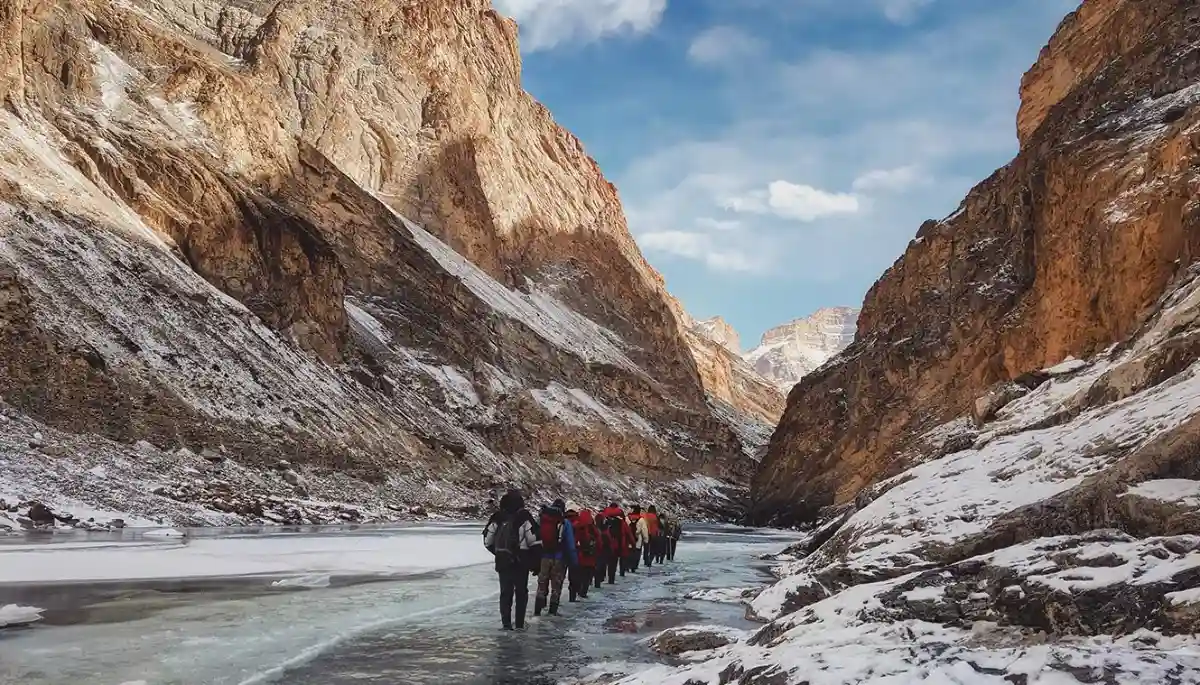
Trek from Shingra Yokma to Shingra Goma
- Altitude: Shinga Goma: 3,200 m / 10,500 ft
- Trek Distance: 5-6 km | 4-5 hrs
After spending your first camping beside the frozen zanskar river, you will wake up to the pretty flow of sunlight bouncing off the icy cliffs. In the morning this view feels straight out of a dream! With warm water or tea you can enjoy the morning of the frozen zankar river!
Today you will trek from Shingra Yokma to Shingra Goma. The walk is longer than yesterday's trek, but so is the experience and thrill of the journey! Every few steps, the texture of the ice changes, sometimes smooth like glass, sometimes layered and powdery. You will find yourself marveling at the natural formations, frozen ice layers, and the stillness that surrounds you.
The trek passes through narrow gorges. Make sure you walk carefully and follow your trek leader’s instructions, as the Chadar can be slippery and unpredictable in places. Your leader will guide you carefully across these varying surfaces.
Soon you will reach Shingra Goma, and this will be your next campsite for the day. You will again stay beside this marvellous frozen river and the view and experience will make your heart happy!
The temperature can dip suddenly and it’s better you keep yourself layered. After dinner, you can rest for the day or just admire the night sky of the Chadar Trek. The night sky above the gorge is full of countless stars, and this experience and essence make everything so surreal and beautiful!
Trek from Shingra Goma to Tsomo Paldar
- Altitude: Tsomo Palder: 3,300 m / 10,800 ft
- Trek Distance: 5-6 km | 4-5 hrs
This morning, you will wake up in the stillness of the frozen Zanskar river. The sun rises above the cliffs, and the icy river shines as glittery as it can be! After your breakfast, you will start today’s trek from Shingra Goma to Tsomo Paldar.
The trail continues along the frozen river, and you will catch a glimpse of ice formation at different points. These formations are so fascinating in every section, some sections are crystal clear, and other ripple like frozen waves. At times, you may also notice rivers flowing beneath the layers of ice!
Moving towards the valley, the rock walls seem rising on the sides. The Chadar route has also long been used by people as a winter pathway between villages in earlier times.
When you reach the Tsomo Paldar, you will feel very quiet and calm! This will be your campsite for the night, and camping in such an area is itself an otherworldly experience!
After the sunset, the temperature drops further and you can feel the coldness of the region. With your hot dinner, you will even enjoy this cold. You can rest for the night and feel the essence of this calm surroundings!
Tsomo Paldar to Shingra Yokma
- Altitude: Shingra Yokma: 3,300 m / 10,800 ft
- Trek Distance: 11-12 km | 7-8 hrs
Today, the day begins early with morning sunshine and a steaming cup of tea! You can enjoy your tea while strolling around and feel the essence of tea blending with the chill of the icy land!
Today’s trek will take you back towards Shingra Yokma, retracing the path you had taken earlier, but this time with a completely new perspective. This time, you will be more confident on the ice and the sights that once felt unfamiliar now feel comforting.
The thrill of walking on a frozen river is so amazing, even though you are walking back, it never feels repetitive. You will experience this joy, enjoy the chilled air and those little sunrays from above. The route passes through narrow gorges and icy bends. The trek might be long, but the beauty of experiencing it again and again is very satisfying!
You will soon reach Shingra Yokma, and this will be your campsite for the night. You will again have time to soak in all the beauty of Chadar and take in as much as you can. Its view, and its essence! After a happy dinner, you can rest for the night!
Trek from Shingra Yokma to Dib/Tilado and drive back to Leh
- Altitude: Tilado: 3300 m / 10800 ft
- Trek Distance: 2 km | 1-2 hrs
- Drive distance: 65 km | 3-4 hrs
Today is the last morning at the frozen river and marks the final day of the Chadar Trek journey! The morning begins, and the icy land shines as usual. The rays of sun make it glow even more. You can enjoy your tea, breakfast and begin your trek from Shingra Yokma to Dib/Tilado.
You can soak in all the beauty of the trek while walking once more over the frozen Chadar. The trek back is short, but you can enjoy every step of it as it will the last of this icy land.
Once you reach Tilado, the vehicles will be there to take you back to Leh. Now, you will finally give some relaxation to your legs and enjoy the drive of this beautiful land. The landscapes of Ladakh are so beautiful, even if you are tired from your trek journey, you will not feel asleep, because you would not want to miss the views!
By late afternoon or evening you will reach Leh and check in to your hotel. After a long journey, you can freshen up and have a hot meal. In the evening, there will be a short debriefing session with your trek leader and team to share moments and thoughts from the trek. The adventure of walking on the frozen Zanskar ends here with wonderful memories and experiences!
Day-1: Arrival at Leh
- Altitude: Leh: 3505m / 11,500 ft
- Accommodation: Hotel
Day-2: Acclimatization Day
- Altitude (Leh): 3505m / 11,500 ft
- Accommodation: Hotel
Day-3: Medical Test Day in Leh
- Today is a Medical Check-up day and it is very important for every trekker to get checked.
Day-4: Drive from Leh to Dib/Tilado and trek to Shingra Yokma
- Altitude:
- Tilado: 3300 m / 10800 ft
- Shinga Yokma: 3,300 m / 10,800 ft
- Drive distance: 65 km | 3-4 hrs
- Trek Distance: 3-4 km | 2-3 hrs
Day-5: Trek from Shingra Yokma to Shingra Goma
- Altitude: Shinga Goma: 3,200 m / 10,500 ft
- Trek Distance: 5-6 km | 4-5 hrs
Day-6: Trek from Shingra Goma to Tsomo Paldar
- Altitude: Tsomo Palder: 3,300 m / 10,800 ft
- Trek Distance: 5-6 km | 4-5 hrs
Day-7: Tsomo Paldar to Shingra Yokma
- Altitude: Shingra Yokma: 3,300 m / 10,800 ft
- Trek Distance: 11-12 km | 7-8 hrs
Day-8: Trek from Shingra Yokma to Dib/Tilado and drive back to Leh
- Altitude: Tilado: 3300 m / 10800 ft
- Trek Distance: 2 km | 1-2 hrs
- Drive distance: 65 km | 3-4 hrs
Note:
Due to ongoing road construction, the visit to Nerak Waterfall is only allowed on Sunday and Wednesday. You will be taken to Nerak on whichever of these days falls during your trek itinerary.
(Nerak is one of the main highlights of the Chadar Trek. The frozen waterfall looks fully covered in ice, and is one of the most beautiful and popular photo points of the trek.)
Chadar Trek Frozen River Graph
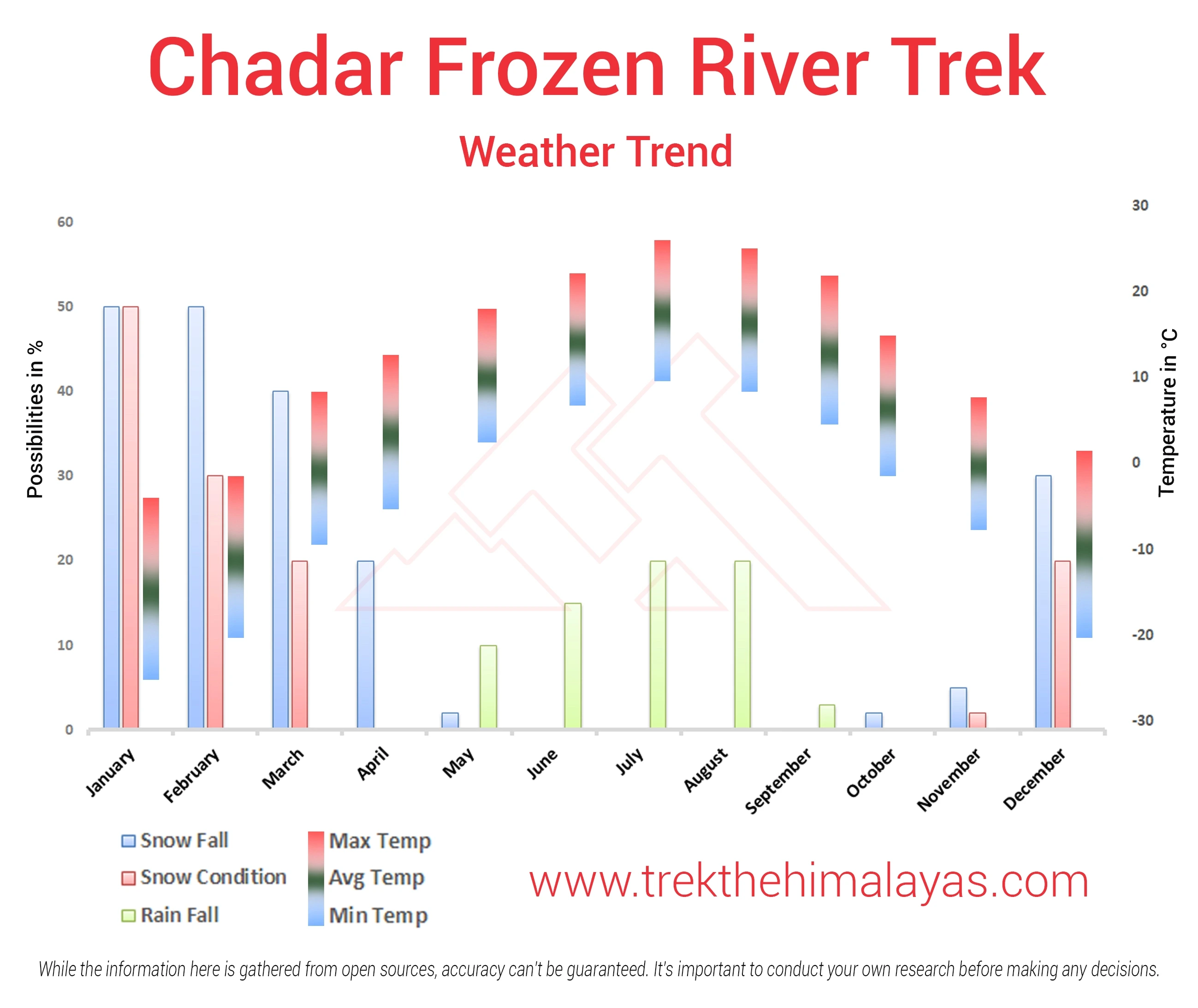
- Pulse rate at rest must be in between (60 to 100 beats per minute).
- Blood Pressure Reading must be in between (DIASTOLIC 75 – 85, SYSTOLIC 100 - 130 mm Hg).
- Respiratory rate at rest must be in between (12 to 20 breaths per minute).
- Should not have Liver and kidney issues.
- Should not have Diabetes Mellitus, Bronchial Asthma, Heart problems, Hypertension, etc.
- No pacemaker implant.
- People with Sinus issues, Epilepsy please contact to trek coordinator before booking the trek.
- If your BMI is not normal, Please contact our Trek coordinator before Trek booking.
Medical & Disclaimer Form (Mandatory Documents) Click here to download Medical & Disclaimer Form
Government employees can avail the benefit of Special Casual Leave (SCL) when they join us for a trekking expedition. As per Pay Commission guidelines, up to 30 days of Special Casual Leave can be availed in a calendar year for trekking or mountaineering expeditions conducted through a registered organisation.
Trek The Himalayas is a registered adventure tour operator with the Indian Mountaineering Foundation (IMF) and the Ministry of Tourism (MoT), making your trek eligible for SCL benefits.
To apply, email us at info@trekthehimalayas at least 20 days before the trek departure date, with the following details:
- Trek name and trek date
- Booking details
- Full name
- Designation
- Department and department address
This benefit is exclusive to Indian Government employees and is applicable only for treks within India.
- Junior trekkers (below 15 years) should have a company of parents/guardians.
- Trekkers between 15 to 18 years can come solo with the disclaimer form signed by parent/guardian.
- Medical & Disclaimer Form (Mandatory Documents) Click here to download Medical & Disclaimer Form
Important Links
- Mandatory Documents to Bring on A Trek Click Here.
- How to pay Add-ons, Submit Medical Forms, and Dietary Preferences Click Here to watch Video
How To Reach
It is essential for everyone to arrive at Leh (01:00 pm)
The only way to travel is to fly to Kushok Bakula Rimpochi Airport located in Leh. It is just 4 km away from the main city. The airport is well connected to Delhi and also receives flights from Mumbai, Srinagar, Jammu, Chandigarh and other general destinations in India. Even international travellers can fly directly from major cities like Kolkata, Mumbai and Delhi.
It's quite convenient to secure a cab from outside the airport to reach our hotel. Alternatively, you can inform your coordinator to arrange a cab for you. Upon booking the trek, your trek coordinator will furnish you with the hotel details.
Travelling by both the road routes, the Manali-Leh Highway and Srinagar-Leh Highway, is not possible since they are not open in the snowy winters of Ladakh.
The Manali-Leh and Srinagar-Leh highways are generally closed by October-November
For your return journey from Leh, you have to choose only air transport options. Please ensure an early check-out in the morning, as all flights operate during the morning hours.
It's highly advisable to keep 2 buffer day in your travel plan. If the buffer day is not needed, it can be used to explore Leh.
.webp)
Cost Terms
Inclusion
1. Accommodation (as per the itinerary):
- Guest house (centrally heated room)(attached washroom) in Leh on Day 1, Day 2, Day 3 & Day 8 (twin sharing basis, triple in very rare cases).
- Camping during the trek (Day 4 to Day 7).
2. Meals (Veg + Egg):
- All meals while on trek. .
- Day 4 breakfast to day 8 lunch.
3. Support:
- 1 Versatile base camp manager handles communication and deploys extra manpower in emergencies.
- 1 Mountaineering & First aid qualified professional expedition leader.
- 1 Experienced high altitude chef.
- Local experienced guides (Number of guides depending on the group size).
- Enough support staff.
4. Trek equipment:
- Sleeping bag, Sleeping liners (if required), Mattress, Utensils.
- 3 men all season trekker tent (twin sharing), Kitchen & Dining tent, Toilet tent.
- Camping stool, Walkie talkie.
- Ropes, Helmet, Ice axe, Harness.
5. First aid:
- Medical kit, Stretcher, Oxygen cylinder, Blood pressure monitor, Oximeter, Stethoscope.
6. Transportation (as per the itinerary):
- Leh (Guest house) to trekking point (Day 4).
- Trekking point to Leh (guest house) (Day 8).
7. Cloakroom service at Leh.
8. Mules/porters to carry the central luggage.
9. Services from Leh to Leh.
10. Trek completion certificate from TTH.
Exclusion
- Insurance
- Food in Leh.
- Any kind of personal expenses.
- Entry fee for sightseeing and monasteries.
- Mule or porter to carry personal luggage.
- Emergency evacuation, hospitalisation charge, etc.
- Any extra costs incurred due to extension/change of the itinerary due to natural calamities roadblocks, vehicle breakdown, etc. factors beyond our control
- Pick up and drop off at Leh airport.
- Any additional cost due to the final decision incurred by the Administrative.
- Environment fee + ILP: Approx Rs. 600 to Rs700 per person. (as per new Guidelines need to pay in Leh only).
- Pre Medical Check-up and Rescue fee, Wildlife/environmental charges, ALTOA NOC, and entry fees up to Rs. 8000 to Rs. 10000 paid to the authority on the spot.
- Anything not specifically mentioned under the head Inclusion.
Things can be provided on demand and availability (participant has to pay extra for these things).
1- Gamow/PAC HAPO Bag (Portable Hyperbaric Bag) - is a unique, portable hyperbaric chamber for the treatment of acute mountain sickness (AMS), also known as altitude sickness.
2- AEDs (Automated External Defibrillators) - are portable life-saving devices designed to treat people experiencing sudden cardiac arrest, a medical condition in which the heart stops beating suddenly and unexpectedly.
Cancellation Terms
To request a cancellation, please email us at info@trekthehimalayas.com using your registered email ID.
Cancellations prior to 25 days from the start of the Trip
Refund Options
- 5% deduction of trek fee
- 100% trek fee cash voucher for any trip till one year
- Transfer your trek (any trek, any date) to your friend
Cancellation between 24 days and 15 days to the start of the Trip
Refund Options
- 30% deduction of trek fee
- 100% trek fee cash voucher for same trip till one year
- 85% trek fee cash voucher for any trip till one year
- Transfer your trek (same trek, any date) to your friend
Cancellation between 14 days and 10 days to the start of the Trip
Refund Options
- 50% deduction of trek fee
- 80% trek fee cash voucher for same trip till one year
- 70% trek fee cash voucher for any trip till one year
- Book the same trek, in the same season, with any other batch
- Transfer your trek (same trek, any date) to your friend
Cancellation less than 9 days to the start of the trek.
Refund Options
- No cash refund
- 20% trek fee cash voucher for the same trip till one year
- 10% trek fee cash voucher for any trip till one year
- Transfer your trek (same trek, same date) to your friend
Cancellation Policy (Emergency Cases):
In case of a death in the immediate family (parents, siblings, spouse, children) or if the trekker is hospitalized (min. 48 hours) or suffers a fracture (leg/arm) within a week before the trek, even if canceled a day before:
90% trek fee refund in cash & 10% as a voucher (valid for 1 year, for any India trek).
Valid documents required. We’re here to support you during tough times.
Note:
- Change of trek batch is dependent on the availability of seats in the batch
- In case of transferring a trek to a friend, he/she should satisfy all the mandatory requirements put forward by TTH
- TTH holds the right to change/cancel the policies, without prior notice
Chadar Trek Force Majeure/Emergency Cancellation Terms:
The Chadar Trek is a uniquely beautiful but inherently unpredictable adventure. Winter conditions, frozen terrain, weather fluctuations and regulatory uncertainties can lead to sudden changes or cancellations. The following policy outlines our approach to handling such situations, ensuring clarity and fairness for all clients.
- In case of airline cancellations that prevent trekkers from arriving in Leh on schedule, trekkers may choose a new trek date (subject to availability) or opt for a full refund.
- In the event of trek cancellation by the government or authorised authorities before trekkers reach Leh will result in a full refund of the trek fee.
- When trekkers reach Leh, but the trek is cancelled before it starts by the authorities or regulatory directive, an alternative trek of comparable value will be offered; no cash refund will be provided.
- Trekkers declared medically unfit during a mandatory check-up (Day 3) on arrival at Leh will receive a 70% refund of the trek fee.
- Once the trek has commenced, no refund shall be given under any circumstances, including cancellation on account of force majeure, government restrictions, or adverse weather.
- All cancellation or refund requests must be submitted in writing (via email); verbal requests will not be considered valid.
Booking and Payments
- The Participant is responsible for verifying the accuracy of all details, including Trip dates and personal documentation, at the time of booking.
- Payments must be made in accordance with the timelines and instructions provided by TTH. Late payments may result in cancellation of booking without refund.
- In the event of a cash refund, only the portion of the payment made in cash shall be eligible for refund in cash. Any booking made using voucher, discounts, promotional codes, or through any non-cash mode of payment shall not be eligible for a cash refund under any circumstances.
- Refunds, if applicable, shall be processed within 15–30 working days of confirmation.
- All add-on bookings are subject to the respective add-on cancellation policy, and refunds will be processed accordingly.
- Voucher Terms
- This is a non-transferable voucher
- The voucher cannot be merged with any other offer of Trek The Himalayas
- The voucher is valid for Trek booked directly with Trek The Himalayas in India
- To avail the voucher please use your register phone number or e-mail id
- All the other Terms of booking a trek with Trek The Himalayas are applicable to the voucher
Itinerary and Modifications
- TTH reserves the right to modify, shorten, or cancel any part of the Trip due to transportation delays, weather, health emergencies, or other unforeseen circumstances including Force Majeure.
Cancellations and Refunds
- No refunds or vouchers, partial or otherwise, shall be provided for voluntary withdrawal, non-utilisation of services, or removal from the Trip.
- If TTH cancels the Trip before arrival at the designated pick-up point due to unforeseen circumstances or Force Majeure, the Participant may choose from:
- An alternate Trip/date.
- A credit voucher valid for one (1) year.
- Transfer to another Trip, with cost differences payable by the Participant.
- If the Trip is abandoned post-arrival at the designated pick-up point, no cash refund or voucher shall be issued. The Trek Again Policy may apply at TTH’s discretion.
- TTH shall not be liable for any associated travel costs such as flights, accommodation, or visa fees.
Force Majeure
- Events beyond its control including but not limited to earthquakes, landslides, strikes, curfews, war, pandemic, government restrictions, heavy rainfall or snowfall, windstorms, road blockages, trail disruption, or withdrawal of permits, TTH shall not be held liable for any cancellation, delay, or service modification caused by Force Majeure.
Trek Essentials
Rent EquipmentPDF Of Trek Essential Download
| Backpack with rain cover | (50 - 60 ltr) with comfortable shoulder straps |
| Day pack with rain cover | 20 - 30 ltr (If off-load opted) |
| Walking stick | Advisable (At least one) |
| Water Bottle / Hydration pack | 2 thermos flask bottles of one liter each, Don't bring hydration pack. |
| Small size tiffin/lunch box | 1 Nos |
| Snacks | Energy bars, dry fruits, electral/ors |
| Personal Medical Kit | Consult your doctor |
| T-Shirt (Synthetic quick dry) | 1 Half sleeves |
| Fleece T-shirt | 2 Nos |
| Fleece jacket | 1 Nos |
| Windproof Jacket | Not required |
| Down feather / Hollow jacket | 1 Nos |
| Thermal inner (Upper and Lower) | 1 Pair |
| Trek Pant (Synthetic quick dry) | Not required |
| Fleece Pant | 2 Nos. |
| Waterproof gloves | 1 Pair |
| Fleece / woollen gloves | 1 Pair |
| Poncho / waterproof Jacket and pant | 1 Nos |
| Sunscreen | 1 Nos. |
| Moisturiser | 1 Nos. |
| Chap-stick / Lip balm | 1 Nos. |
| Toothbrush and toothpaste | 1 Nos. |
| Toilet paper & Wipes | 1 Nos. |
| Hand sanitizers | 1 Nos. |
| Antibacterial powder | 1 Nos. |
| Quick dry towel | 1 Nos. |
| Head torch | 1 Nos. (Avoid Hand torch) |
| Sun Cap | Not required |
| Woolen cap | 1 Nos. |
| Balaclava | 1 Nos. |
| Buff / Neck-gaiters | 2 Woollen |
| Sunglasses | UV with dark side cover, People who wear spectacles - (A)- Avoid contact lenses | (B)- Photo chromatic glasses |
| Trekking shoes | 1 Pair (Gumboots) |
| Floaters / flip-flops | Not required |
| Cotton socks | 3 pairs |
| Woollen socks | 4 pairs |
| Gaiters | Not required |
| Micro spikes | Not Allowed |
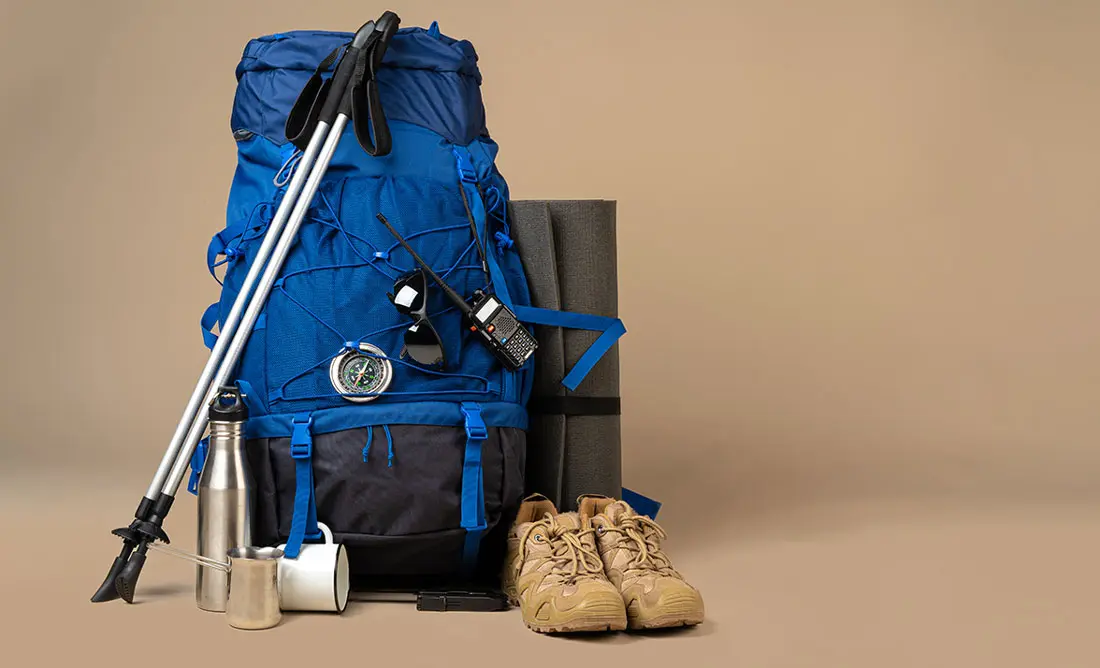
Frequently Asked Questions(FAQ)
To register with TTH, visit our website - www.trekthehimalayas.com and create your account. To create your account you will need to use your email address and fill in all the details, set your unique password and your account is ready to use.
- To book a trek with TTH, you first need to register with us and create an account.
- Choose the trek that you want to do and click on available dates.
- You will land at the login page, fill in the required details.
- Add Participants, choose add-on services click on the Pay now button, choose your preferred payment method, and make the payment. TTH accepts multiple payment options, including credit/debit cards, net banking, and UPI.
- You will receive a confirmation email from TTH with all the necessary details about the trek, including the meeting point, transportation, accommodation, and other important instructions.
- Click Here to watch Video
please send an email to us at info@trekthehimalayas.com or reach out to the numbers provided in the Help and Support section of your Trek Page. We will ensure that your issue is promptly resolved.
To book services such as off-load luggage and transportation, you can find them listed as add-ons. These additional services can be booked at the time of your initial booking. If you miss booking add-ons during the initial reservation, you can log in anytime and easily book 4 days before the departure date add-ons through the platform.
If you have booked the wrong trek or selected the wrong date, don’t worry! You can contact us at +91 9368882322 (Monday to Saturday, 10 AM to 10 PM) or email us at info@trekthehimalayas.com. You can also discuss this with your trek coordinator. Please make sure to inform us at least 10 days before the departure of your trek. Only then can we help you reschedule or arrange another trek for you.
We recommend visiting our "Suggest Me a Trek" page. By filling out the form, our experts will contact you with the best possible trek options based on your preferences and experience level. Alternatively, you can reach out to us via email at info@trekthehimalayas.com or give us a call using the numbers provided on our website for personalized assistance and recommendations.
Family treks differ from regular treks by focusing on ease of difficulty, offering shorter durations for younger participants, Kid-friendly and easily digestible foods, child-friendly activities, maintaining a higher guide ratio for diverse age groups, and implementing additional safety measures for families.
Family Trek with Kids recommendation Only Dayara Bugyal and Chopta Chandrashila Trek.
Minimum age for TTH treks is typically 7 years, though this may vary depending on the specific trek.
Yes, you can take a kids to a high-altitude trek with a parent. Discuss with a trek expert before booking a trek.
- Junior trekkers (below 15 years) should have a company of parents/guardians.
- Trekkers between 15 to 18 years can come solo with the disclaimer form signed by parent/guardian.
- Medical & Disclaimer Form (Mandatory Documents) Click here to download medical and disclaimer form
Physical Fitness: Ensure your child is physically fit. Engage them in regular exercise, outdoor activities, and hikes to build stamina and endurance. Hydration: Emphasize the importance of staying hydrated at high altitudes. Encourage your child to drink water regularly, even if they don't feel thirsty. Proper Nutrition: Provide a well-balanced diet with sufficient carbohydrates for energy and foods rich in iron to prevent altitude sickness. Adequate Sleep: Ensure your child gets enough sleep in the days leading up to the trek. Quality rest is crucial for altitude adaptation. Educate on Altitude Sickness: Teach your child about the symptoms of altitude sickness, such as headache, nausea, and dizziness. Encourage them to communicate any discomfort immediately. Appropriate Clothing and Gear: Dress your child in layers to adjust to changing temperatures. Ensure they have appropriate trekking gear, including sturdy footwear. Positive Mindset: Foster a positive mindset. Encourage your child, and let them know it's okay to take breaks when needed. Medical Check-Up: Schedule a medical check-up before the trek to ensure your child is fit for high-altitude activities. Consult with a healthcare professional about any potential health concerns.
TTH takes special care to provide wholesome and nutritious food for children on treks. Here are some of the foods that are typically served for children:
Breakfast: For breakfast, TTH serves a variety of options like porridge, cornflakes, bread, butter, jam, honey, boiled eggs, omelettes, and pancakes. Children can choose from these options to fuel themselves for the day's trek.
Lunch: For lunch, TTH serves lunch which includes rotis, vegetables, rice, dal, and salad. The rotis are usually made fresh on the trek and are a good source of carbohydrates. The dal and vegetables provide protein and other essential nutrients.
Snacks: TTH provides healthy snacks like fresh fruits, dry fruits, energy bars, cookies, and biscuits to keep the children energized throughout the day.
Dinner: For dinner, TTH serves a hot and wholesome meal which includes soup, rice, dal, vegetables, and a non-vegetarian dish (if requested in advance). Children can also choose from a variety of desserts like custard, jelly, and fruit salad.
Dietary requirements: If a child has any special dietary requirements, TTH can cater to those needs as well. For example, if a child is lactose intolerant or allergic to nuts, the kitchen staff can make arrangements to accommodate those requirements.
Choosing the right trek for a beginner can be a bit overwhelming as there are many factors to consider such as distance, elevation gain, terrain difficulty, weather, and time of year. Here are some tips that can help you choose the right trek for a beginner:
1. Determine fitness level: Assess the fitness level of the beginner to understand their physical capabilities. This will help you select a trek that is challenging but not too difficult.
2. Choose a well-traveled trail: A well-traveled trail will have more amenities such as signposts, water stations, and shelter. It is also safer as there will be other hikers on the trail.
3. Consider the length of the trek: For beginners, it is recommended to start with a shorter trek that can be completed in a day or two. This will help them get acclimatized to trekking and build their confidence.
4. Look for gradual elevation gain: Choose a trek with a gradual elevation gain rather than steep ascents. This will make the trek easier and more enjoyable.
5. Check the weather: Check the weather forecast before selecting a trek. Avoid treks during the monsoon season or winter when the trails can be slippery or dangerous.
6. Research the trail: Read about the trail to get an idea of the terrain, altitude, and difficulty level. This will help you select a trek that is suitable for the beginner.
7. Consult with an expert: If you are unsure about which trek to choose, consult our trek expert Mr. Nitin (+91 70600 59773) between 10 AM to 6 PM (Tuesday - Friday). Mr. Nitin will provide you valuable advice and guidance.
Overall, it is important to choose a trek that is enjoyable, challenging but not too difficult, and suitable for the beginner's fitness level and experience.
It is not recommended for a beginner to choose a difficult Himalayan trek. Trekking in the Himalayas can be physically and mentally challenging, especially if you are not used to the high altitude, steep slopes, and rugged terrain. Choosing a difficult trek without the proper experience, fitness level, and preparation can be dangerous and put you at risk of altitude sickness, injury, and other hazards.
If you are a beginner, it is recommended to start with an easier trek and gradually build up your skills and experience. This will help you understand the challenges of trekking in the Himalayas, and also prepare you physically and mentally for a more difficult trek in the future. It is also important to choose a trek that matches your fitness level, experience, and interest.
There is no specific age limit for a beginner trekker. However, it is important to consider your physical fitness, health condition, and personal interests before embarking on a trek. Trekking in the Himalayas can be physically and mentally demanding, and requires a certain level of physical fitness and endurance.
If you have any pre-existing medical conditions or are above a certain age, it is recommended to consult with a doctor before embarking on a trek. It is also important to listen to your body and take breaks as needed during the trek to prevent exhaustion or injury.
We recommend visiting our "Suggest Me a Trek" page. By filling out the form, our experts will contact you with the best possible trek options based on your preferences and experience level. Alternatively, you can reach out to us via email at info@trekthehimalayas.com or give us a call using the numbers provided on our website for personalized assistance and recommendations.
Yes, you can join the trek. We have fixed departure groups where you can simply book your trek and we will take care of curating a group.
Before you start the trek, it is recommended that you make all the necessary phone calls as during the trek you may or may not receive network coverage, once you come back to the Base Camp, you can reconnect with your family via phone once again. You can share your trek coordinator contact detail with your family members to get the latest updates about your trek batch.
At TTH, we provide wholesome and nutritious meals during the trek. The food is vegetarian and includes a variety of dishes such as rice, dal, vegetables, chapati, paratha, pasta, noodles, and soup. We also offer snacks such as biscuits, and salty, and dry fruits during the trek. Special dietary requirements such as vegan, gluten-free, or Jain food can also be arranged if informed in advance.
If you are allergic to some foods, you need to let us know in advance so that we can make arrangements accordingly.
TTH is a trekking company that prioritizes the safety of all its participants, including women trekkers. We have a comprehensive safety system in place, which includes a dedicated team of experienced and trained trek leaders and support staff who are equipped to handle emergency situations and provide first aid.
TTH also takes specific measures to ensure the safety and comfort of women trekkers. They have a separate tent accommodation for women trekkers, female trek leaders, and support staff. They also provide separate toilet facilities for women and encourage a safe and respectful environment for all trekkers.
Moreover, TTH has a strict policy against any kind of harassment and has a zero-tolerance policy towards such incidents. They have a designated Internal Complaints Committee (ICC) to investigate and address any complaints related to harassment or misconduct. Overall, TTH has a good reputation for safety and responsible trekking practices, and women can feel comfortable and safe while trekking with them.
In case you are the only women in the group, we provide a single sleeping arrangement. Also, during the trek, the trek leader will always remain by your side to provide optimum safety and reassurance.
You can reach out to the trek coordinator to inquire about the number of female trekkers and their respective states who have booked the trek. Please note that the trek coordinator cannot disclose personal details of any trekker. Once you've confirmed your booking, a WhatsApp Group will be created for all the trekkers in your batch. This allows you to connect with fellow trekkers before the trek begins.
While many of our treks are led by female trek leaders, however, it is not possible to know which trek leader is assigned to which group. But nonetheless, whether the trek leader is male or female you can be completely assured of your safety and security with us.
Yes, it is possible to trek with periods. However, it is important to take some extra precautions and preparations to ensure a comfortable and safe trekking experience. Here are some tips that can help you trek during your period:
1. Use menstrual hygiene products that you are comfortable with, such as tampons, pads, or menstrual cups. It is recommended to carry enough supplies for the entire duration of the trek.
2. Pack wet wipes, hand sanitizer, and plastic bags to dispose of used hygiene products.
3. Wear comfortable and breathable clothing that allows for easy movement and reduces friction. Avoid wearing tight or restrictive clothing that can cause discomfort.
4. Carry pain relief medication, such as ibuprofen or acetaminophen, in case of menstrual cramps.
5. Stay hydrated and maintain a balanced diet to support your energy levels and overall health.
6. Take breaks as needed and listen to your body. If you feel uncomfortable or experience any unusual symptoms, seek medical attention immediately. It is also recommended to consult with a doctor before going on a trek during your period, especially if you have a pre-existing medical condition or are taking medication.
By taking necessary precautions and being prepared, you can have a safe and comfortable trekking experience even during your period. We provide proper disposal facilities for sanitary pad disposal during the trek.
We offer three person tents with twin-sharing for optimum comfort. A woman trekker will share a tent with another woman trekker and if you are the only woman in the group, you will be given a single accommodation for your comfort and privacy.
Yes, we do provide gears on rent. You can book it using you TTH account directly.
Mountaineering qualified Experienced and first aid certified Trek Leader, First Aid Certify local guide, Cook, helpers and supporting staff.
People suffering from Bronchitis, Asthma, High blood pressure, Epilepsy (got faints), TB , Heart problem or on higher BMI side are strictly not allowed to go on any Himalayan trek. Apart from this if you had any medical history, please let us know.
No. Alcohol and smoking isn’t allowed while on trek. It is totally misconception that it will keep you warm. Your body need to acclimatize properly and for that eat properly and drink enough water; these things will keep you warm.
Toilet tents provide a convenient solution for answering nature's call in the great outdoors. Dry toilets, in particular, offer a highly sanitary approach. By digging a pit and utilizing mud and a shovel, you can easily cover up your waste. This method ensures cleanliness and hygiene while camping or exploring in the forest.
Remember to pack essential toiletries to complete your outdoor bathroom kit and maintain proper personal hygiene during your adventures. With these practices in place, you can enjoy nature while also respecting it.
Layer Up From Head To Toe
Eat Full Meals, never sleep empty stomach
You can keep warmee (if you’re more susceptible to cold).
Use sleeping bag in right way and don’t leave free space in sleeping bag.
For upper body
– Thermal layer
– T-shirt (full-sleeves)
– Fleece T-shirt (for extreme colds)
– Fleece layer
– Thick Jacket/Down Jacket
– Waterproof or Windproof layer (outermost layer, when it is snowing or raining)
- For Lower Body
– Thermal layer
– Hiking pants (normal) or Winter hiking pants
Based on how warm you feel you can skip any of the above layers. Your outer later should be windproof since it is windy at high altitude.
The idea behind layering is that the more insulation you have the less cold you feel, and instead of wearing a very thick jacket if you wear multiple layers, your body will be better insulated against the cold.
Yes, we provide micro spikes and gaiters, if required.
Mandatory documents: 2 xerox of ID having address (addhar card/driving license), 2 Passport size photographs, hard copy Medical form signed & sealed by doctor, disclaimer form sign by trekker and high altitude insurance.
No. We don’t but we can suggest you good hotel/Stay nearby pick up location.
Yes, trekker must carry 2 water bottles 1 litre each so they can refill it at campsite for drinking and keep themselves hydrate.
You should buy shoes which has these three features –Good grip, Ankle Support and additional water resistant layers. Generally, we advise Quechua Trek 100, MH 500 and MH 100.
No one is forced to go on. There is always enough staff to split the party according to need and regroup later at the camp. Most people have no trouble reaching the highest campsite. If some members decide not to climb the final distance they can wait for the climbers to come back down the same way or take a lateral path to the descent route.
The Chadar Frozen River Trek is a popular winter trek in the Indian state of Jammu and Kashmir. It involves walking on a frozen river, the Zanskar River, which is transformed into a thick sheet of ice during the winter months. The trek is known for its scenic beauty and challenging terrain, as well as the unique experience of walking on a frozen river.
The best time to do Chadar Frozen River Trek is during the months of January and February when the river is frozen enough to support the weight of trekkers.
Chadar Trek Frozen River is a Difficult Grade Trek.
It is an 8 days long trek.
Yes, altitude-related concerns can be a factor on the Chadar Frozen River Trek. The trek starts at an altitude of around 3,300 meters and reaches a maximum altitude of approximately 3,850 meters. While this may not be extremely high, it is still significant enough to cause altitude-related issues for some trekkers.
Altitude sickness, also known as acute mountain sickness (AMS), is a common concern on the Chadar Trek. Symptoms of AMS can include headache, nausea, dizziness, and shortness of breath. Trekkers can take several precautions to avoid AMS, such as acclimatizing properly, drinking plenty of fluids, and taking necessary medications.
It is also essential to be aware of frostbite and hypothermia, which can occur due to exposure to cold temperatures and wind on the trek. Trekkers should dress in layers, wear proper gear, and stay warm to prevent these conditions.
Overall, while altitude-related concerns are something to keep in mind, with proper preparation and caution, many trekkers are able to successfully complete the Chadar Frozen River Trek without any significant issues..
The Chadar Frozen River Trek is a challenging winter trek that requires specialized gear to ensure the safety and comfort of trekkers in extreme cold and icy conditions. Here are some essential gear items needed for the trek:
1. quality trekking boots with sturdy soles and good traction to provide adequate grip on slippery ice.
2. Warm and waterproof clothing, including thermal layers, fleece jackets, and down jackets, to keep you warm in sub-zero temperatures.
3. Waterproof gloves or mittens and socks to keep your hands and feet dry and warm.
4. A warm hat and a balaclava or a face mask to protect your face from the cold winds.
5. Sunglasses to protect your eyes from the glare of snow and ice.
6. Trekking poles to help maintain balance and stability on the icy terrain.
7. Sleeping bags are rated for sub-zero temperatures to ensure a good night's sleep in the extreme cold.
8. Headlamp or flashlight with extra batteries to navigate in the dark.
9. First aid kit including altitude sickness medication, pain relievers, and basic medical supplies.
10. Backpack with at least 60 liters capacity to carry all your gear and supplies.
During the Chadar Trek, TTH provides all meals, including breakfast, lunch, and dinner. The meals are prepared by a team of experienced cooks, who use fresh and locally sourced ingredients to provide nutritious and tasty food to the trekkers.
While prior trekking experience is not strictly necessary for the Chadar Frozen River Trek, it is highly recommended that trekkers have some level of physical fitness and experience with hiking or trekking in challenging terrain. The trek is considered to be a moderately difficult trek, and the icy conditions can make it even more challenging.
It is important to note that the Chadar Trek requires trekkers to walk on a frozen river, which can be slippery and unstable. Trekkers must also navigate through narrow gorges, steep canyons, and frozen waterfalls, which can be physically demanding. Therefore, it is recommended that trekkers engage in regular physical exercise and prepare themselves mentally and physically for the trek.
Additionally, trekkers need to be prepared to face extremely cold temperatures, which can drop to as low as -25 degrees Celsius at night. Therefore, it is essential to have appropriate gear and clothing to keep warm and protect against frostbite and hypothermia.
It is recommended that trekkers engage in regular physical exercise and prepare themselves mentally and physically for the trek.
Here are some specific physical fitness requirements for the Chadar Frozen River Trek:
1. Cardiovascular endurance: Trekkers need to have good cardiovascular endurance to tackle challenging terrain and high altitude. Regular cardio exercises such as running, cycling, or swimming can help improve endurance.
2. Strength training: Trekkers need to have strong leg and core muscles to maintain balance and stability on the icy terrain. Strength training exercises such as squats, lunges, and planks can help build these muscles.
3. Flexibility: Trekkers need to have good flexibility to prevent muscle strain and injuries. Regular stretching exercises such as yoga or Pilates can help improve flexibility.
4. Mental toughness: The Chadar Trek can be mentally challenging due to the extremely cold temperatures, long hours of walking, and unpredictable weather conditions. Trekkers need to be mentally prepared to face these challenges and stay motivated.
It is important to note that the physical fitness requirements for the Chadar Trek can vary depending on the individual's age, health, and fitness level. It is recommended that trekkers consult with a doctor or a fitness trainer before embarking on the trek to assess their physical fitness and determine any necessary precautions or preparations.
It is highly recommended. The Chadar Trek is a challenging trek that requires specialized gear, experienced guides, and support staff to ensure the safety and well-being of trekkers. Hiring an expert trekking organization can provide many benefits, including safety, specialized gear and equipment, and logistics and support.
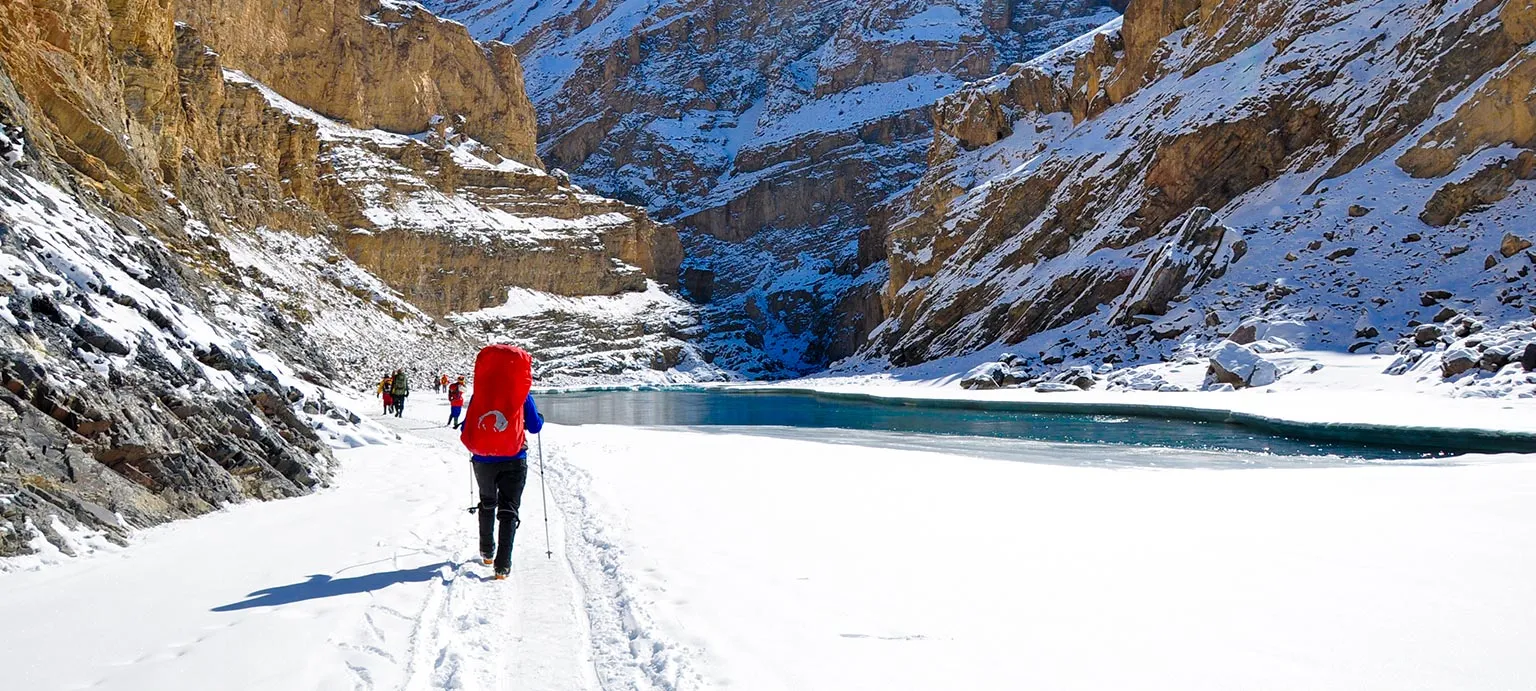
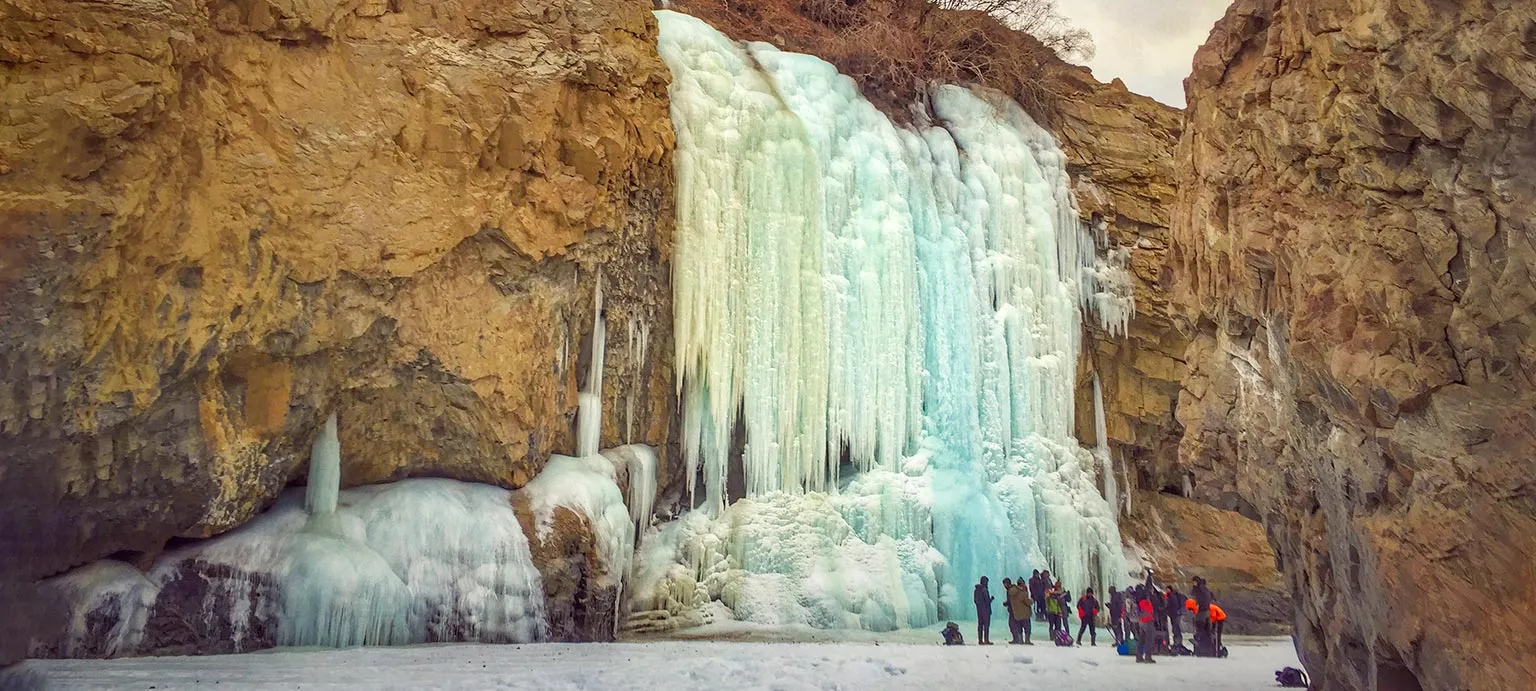
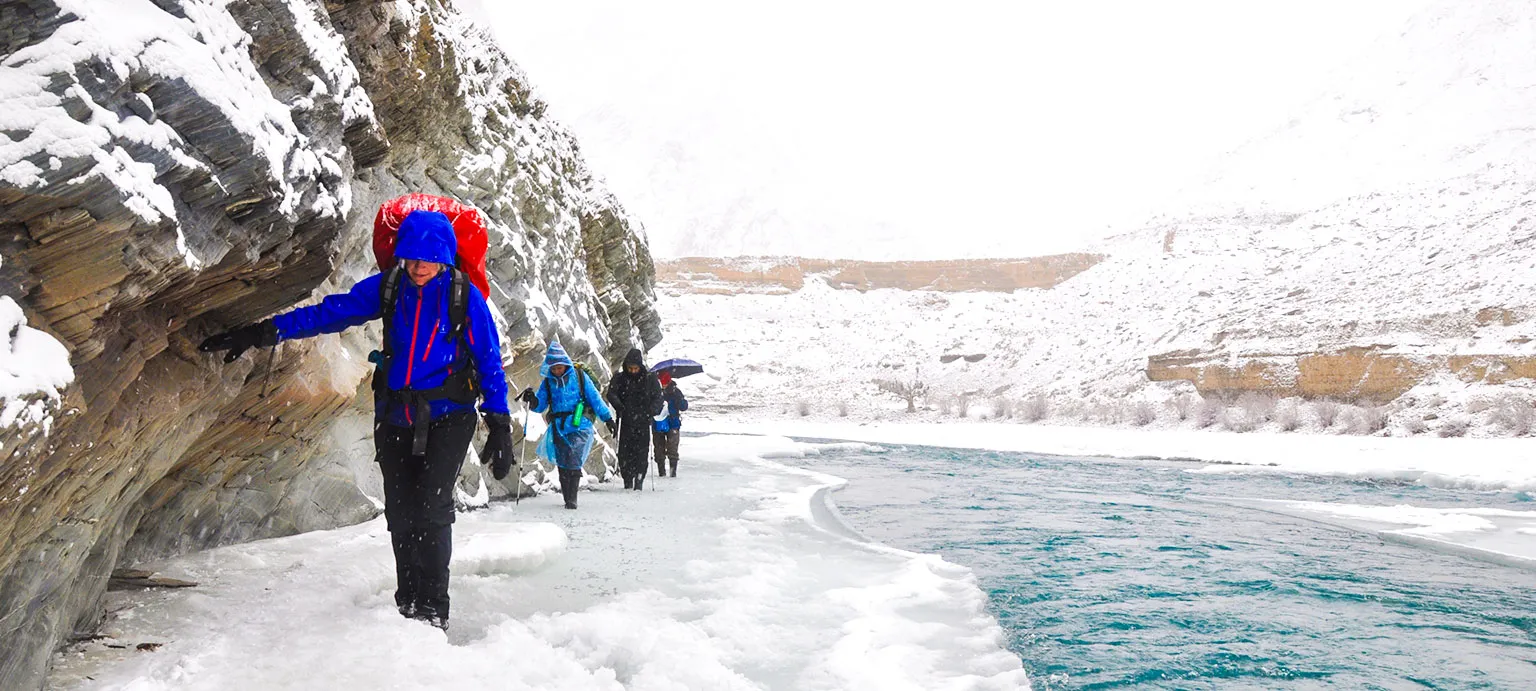
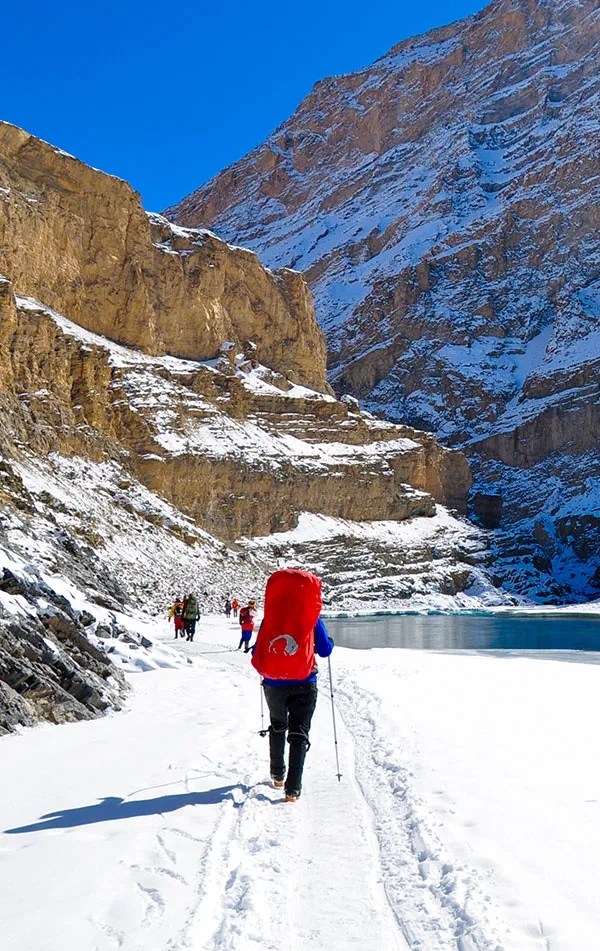
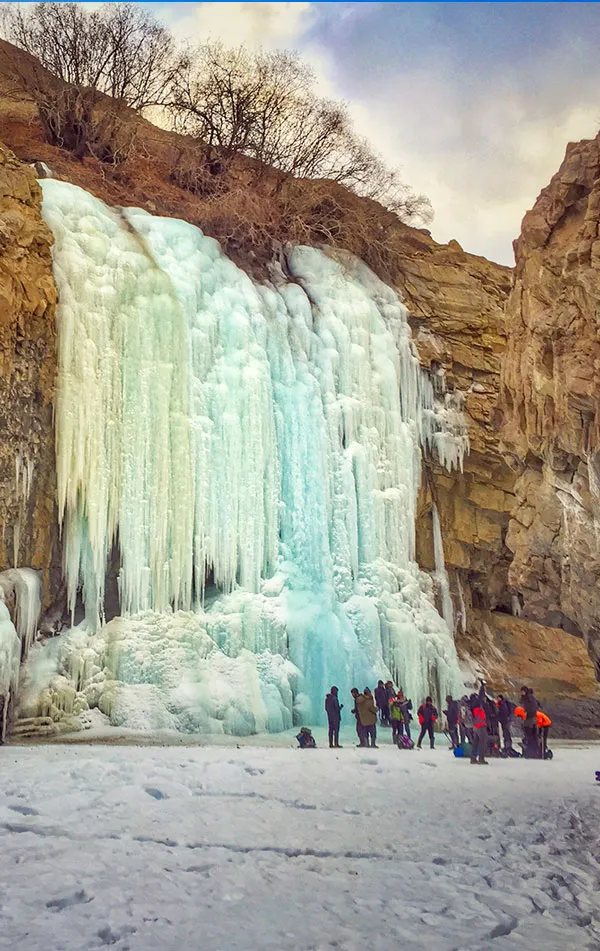
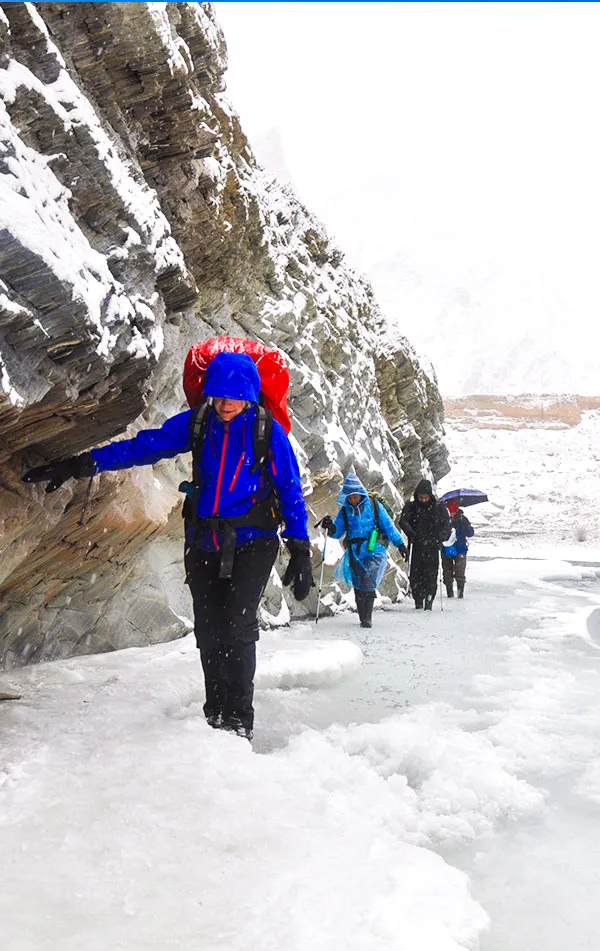
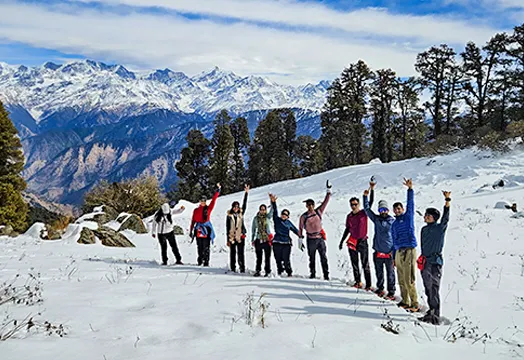
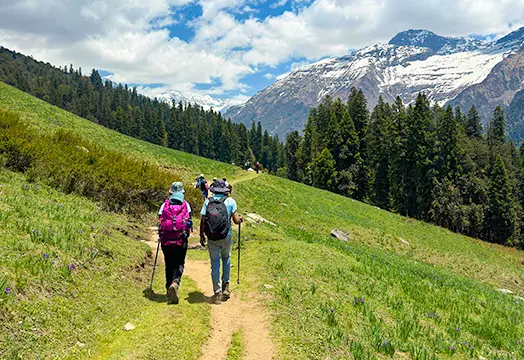
_11zon.webp)
_11zon.webp)
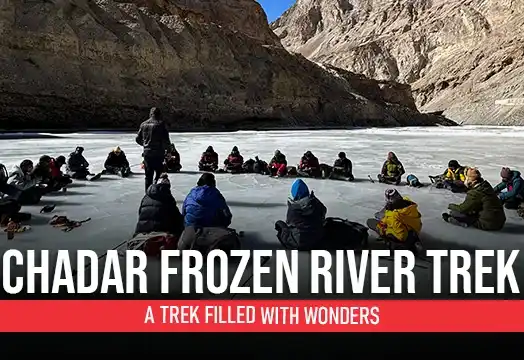
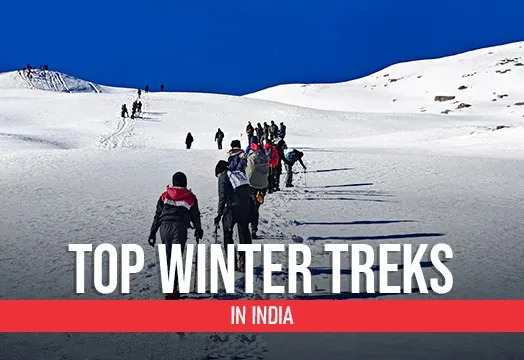
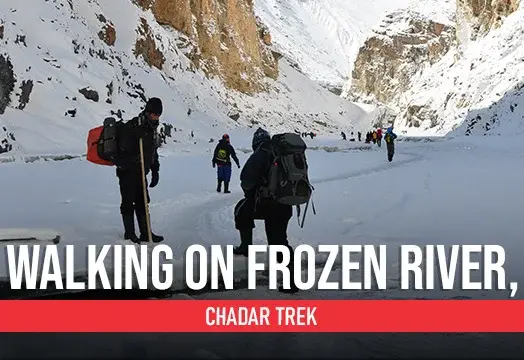
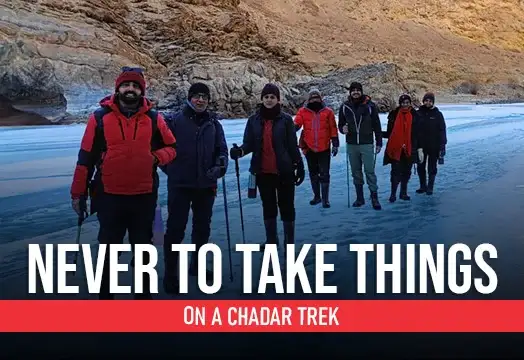
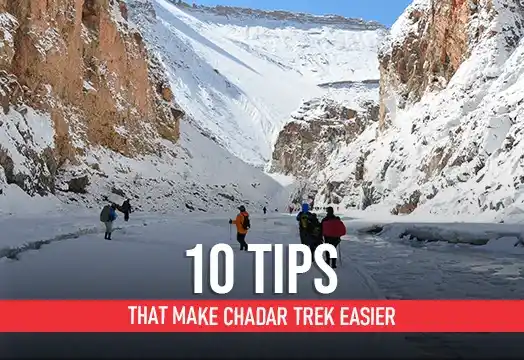
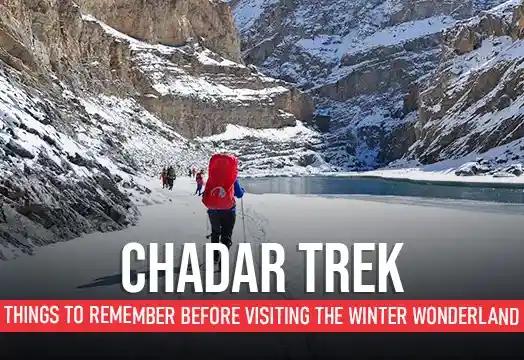
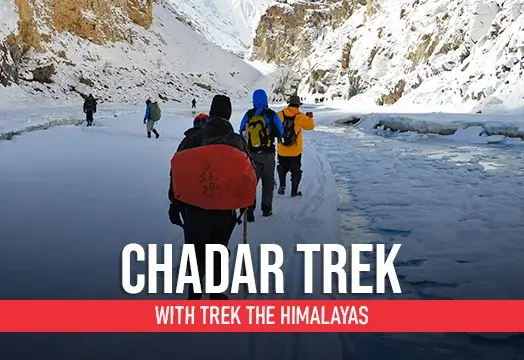
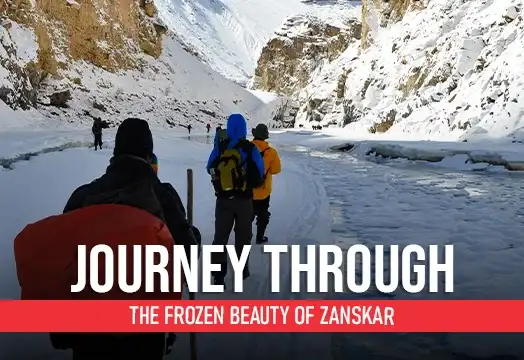






--updated_11zon.webp)

